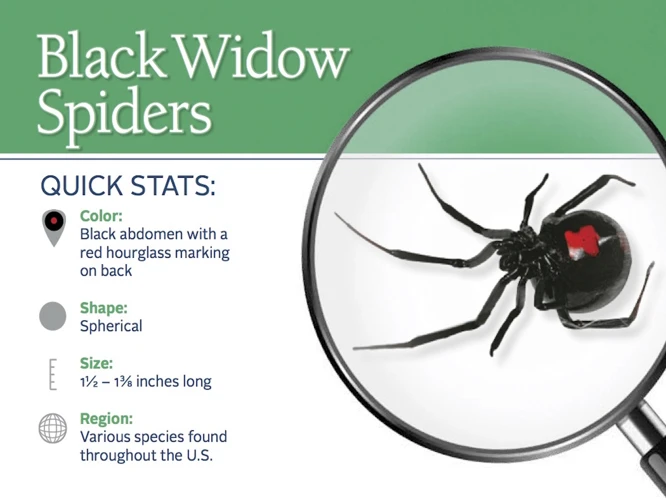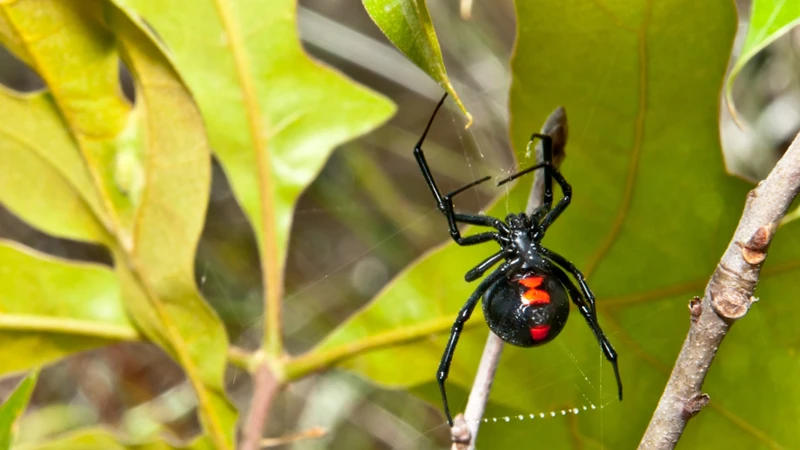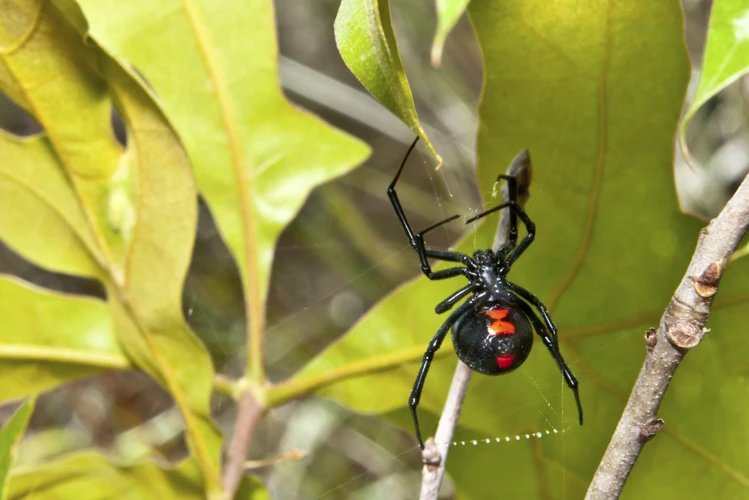As arachnids, black widow spiders have been known to cause fear and panic in many people due to their venomous nature. Nevertheless, they cannot be discounted for their unique physical characteristics that have helped them adapt to different environments over time. This article delves into how black widow spiders have been resilient in adapting to various habitats and the significance of their adaptability. From the differences in physical characteristics to behavioral adaptations, the adaptability of black widow spiders sheds light on the wonders of evolution.
Physical Characteristics of Black Widow Spiders

When it comes to insects, often the physical characteristics determine their success in their respective environments. Black widow spiders, for instance, boast a number of unique attributes that have helped them adapt and survive in a range of different habitats. From their sensory capabilities to their venomous glands, black widows are well-equipped to thrive in their surroundings. In this section, we will explore the various physical characteristics that make the black widow spider such a formidable creature, including their anatomy, coloration, and fangs.
Overview of Physical Characteristics
The physical characteristics of black widow spiders are quite distinct and unique. They are small spiders, usually around 1.5 inches in length. Black widows get their name from the female spider’s tendency to eat the male spider after mating. One of the most recognizable features of the black widow spider is the bright red hourglass-shaped mark on the underside of their abdomen, especially on adult females. But that’s not the only identification mark for black widows, as their coloration and patterns vary between species and geographically diverse locations.
Black widow spiders have a hard exoskeleton that provides them protection and makes their bodies appear shiny. Their sensory capabilities are remarkable – they have eight eyes that are arranged in two parallel sets of four, and their vision is quite good. The eight long legs of these spiders have tiny, sharp claws that help them grip and move quickly to capture their prey. The black widows’ exoskeleton is covered by hair, which serves multiple functions like sensing the environment, regulating temperature, and providing a better grip during movement.
The black widow spider’s fangs are probably the most conspicuous feature of its physical makeup. These are long, slender, curved structures that jut out from their mouthparts, used to inject venom into their prey. They also aid the spiders in the process of feeding. The venoms glands of black widows are quite large and positioned close to the tip of their fangs, which allows them to deliver very potent venom in small quantities.
There are different species of black widow spiders living all around the world. Each species seems to possess specific adaptations that allow them to survive and reproduce more efficiently in their respective environments. There are variations in physical characteristics across geographical locations and environmental conditions. For example, juvenile black widows may have different traits compared to adult black widows, and the coloration is significantly different between males and females.
Understanding the physical characteristics of black widow spiders and how they adapt to the changing environment is crucial for both scientific and practical reasons. Now that we know more about their sensory capabilities, anatomy, and specialized traits, we can study how they survive, hunt, and mate. It enables us to identify and differentiate between black widow spiders and other spiders that share habitat with them.
Variations in Physical Characteristics in Different Environments
Black widow spiders are widely distributed in different climatic conditions around the world. Due to this, they have undergone some physical variations in their characteristics to adapt to diverse environments. For instance, black widow spiders in the tropics have longer legs in comparison to those in temperate regions. This physical characteristic helps them to move more effectively through the dense vegetation in the tropics.
Another physical characteristic that changes due to differences in the environment is their coloration. In dry areas, black widow spiders tend to be lighter in color, while in areas with higher humidity, they become darker. This variation in coloration is an adaptation to camouflage with their environment and protect them from predators.
Black widow spiders in urban areas have adapted to changes caused by human activity. They have become more nocturnal and adept at hiding, which helps them to avoid detection by people and animals. These behavioral changes have been critical to the survival of the spider species in urban environments.
Apart from these characteristic variations, juvenile black widow spiders may also display different physical features than adult black widows. They have a less toxic venom and less prominent body markings. The less prominent body markings help the juvenile spiders evade predators and prey with adaptation to their new environment.
In conclusion, different environments exert significant selective pressures that trigger the evolution of physical adaptations in black widow spiders. These physical variations and behavioral changes make them well adapted to the environment and help them survive better. As we can see, adaptation can take many forms, and black widow spiders have proved to be especially well-adapted to a wide range of environments.
How Black Widow Spiders Adapt to Their Environment

How do Black Widow Spiders Adapt to Their Environment?
Adaptability is crucial for the survival of any species in challenging environments. Black widow spiders are no exception to this rule. These spiders have evolved a number of strategies to cope with different environments through various physical and behavioral adaptations. In this section, we will explore how black widow spiders adapt to their environment by looking at their survival strategies and behavioral changes. Understanding these adaptations is critical for identifying and managing black widow spider populations.
Survival Strategies
The Black Widow spider’s physical characteristics enable them to survive in a variety of environments, but they also have a few specific survival strategies that have allowed them to thrive over time. These strategies include staying hidden, utilizing their venom, and adapting to changing conditions.
One of the key survival strategies of the Black Widow spider is to stay hidden from predators and prey alike. They do this by building webs in dark, sheltered areas like crevices, hollows, and burrows. An interesting adaptation is the ability of larger females to camouflage themselves by adding bits of debris or other materials to their web, which allows them to blend in with their surroundings and avoid detection.
Another essential survival strategy of the Black Widow spider is their venom. Their venom glands, located in their cephalothorax, produce a potent neurotoxin that can quickly immobilize their prey. The venom is injected through the Black Widow’s fangs, which are extremely sharp and precise. The exoskeleton of the spider also provides an extra layer of protection while they are attacking their prey.
The Black Widow spider’s hairs also play a significant role in their survival. These tiny sensory structures located on the spider’s legs and body help them detect vibrations, air currents, and chemical cues in their surroundings, allowing them to sense when potential prey is nearby. Their sensory capabilities also allow them to detect the presence of predators and take evasive action or prepare for a fight.
Finally, the Black Widow spider’s adaptability is also a crucial survival strategy. They can adjust to varying environmental conditions by altering their web-building and hunting behaviors. For example, younger spiders may produce smaller webs than older spiders, and they may use different web designs depending on what prey is available in their environment at any given time. This adaptability not only allows them to survive but to also thrive in a range of different environments and situations.
The combination of hidden webs, potent venom, keen sensory capabilities, and adaptability make the Black Widow spider a formidable predator. These survival strategies ensure that they can thrive in a wide range of environments and continue to thrive in many different habitats.
Behavioral Changes in Different Environments
Black Widow spiders are highly adaptable to various environments due to their behavior and physical characteristics. These spiders exhibit different behavioral changes to adapt in different environments. Here are some of the behavioral changes that they exhibit:
Feeding Habits:
Black Widow spiders have unique feeding habits which point towards their adaptability. They catch and eat insects, spiders, and other arthropods. They catch their prey in webs that they spin. Once caught, the prey is immobilized using the spider’s venom. The spider then slowly consumes the immobilized prey. To adapt to different environments, black widow spiders modify their feeding habits. When food is scarce, they can go for months without eating. They also adjust their diet to prey that is more abundant in their environment.
Mating Habits:
Black widows have specific mating habits which are crucial for their survival. The female black widow is larger in size than the male. During mating, the female sometimes kills the male. Once mating has occurred, the female lays between 100 to 400 eggs, which are protected in a sac made of silk. To adapt to different environments, black widow spiders modify their mating habits. For example, in cooler climates, mating occurs indoors in sheltered areas while in warmer climates, mating happens in more open areas.
Movement and Habitat:
Black Widow spiders’ behavior changes according to their habitat. They prefer warm climates where hunting for prey is easy. They are also found in a variety of habitats, including forests, deserts, and fields. Black widow spiders have the ability to move around in different environments due to their physical characteristics. They have strong legs which help them move across different surfaces. They also have fine sensory hairs and auditory organs which help them detect prey and danger.
Black Widow spiders adapt to various environments through their behavioral changes. They modify their feeding habits, mating habits, and movement patterns to survive different environments. Their physical characteristics such as their strong legs, fine sensory hairs, and auditory organs play an important role in their adaptability. Understanding the behavioral changes of Black Widow spiders in different environments can benefit researchers in studying the wider scope of animal behavior.
The Significance of Adaptability of Black Widow Spider Physical Characteristics
The adaptability of black widow spider physical characteristics is significant for their survival and successful migration to different environments. The black widow spider has a unique set of physical characteristics that allow them to easily adapt to various environments and conditions.
For instance, the sensory capabilities of the black widow spider allow them to detect prey and predators in different surroundings. Their exoskeleton provides them protection and support, enabling them to remain unharmed in different temperatures and habitats. Additionally, their venom glands give them the ability to immobilize their prey instantly, while their formidable fangs help them to penetrate the exoskeleton of the prey.
The adaptability of the black widow spider’s physical characteristics is crucial in helping them survive predators and other environmental changes. For instance, the black widow spider’s coloration and identifying markings help to differentiate them from other spiders and predators, enabling them to avoid being preyed upon. Their special hairs also provide unique functions such as sensory and thermal insulation.
Without the adaptability of their physical characteristics, black widow spiders would face extinction. This adaptability is an essential factor in their ability to survive various environmental changes and challenges.
Conclusion
In conclusion, we can say that the adaptability of black widow spider physical characteristics is an amazing example of evolution in action. The physical and behavioral changes that these spiders go through in order to survive in different environments are remarkable. From changes in coloration to variations in sensory capabilities, black widow spiders have developed various survival strategies.
One of the key findings in this study is that the physical characteristics of black widow spiders vary in different environments. This suggests that these spiders are constantly adapting to their surroundings and that, through natural selection, certain characteristics are favored over others in different environments.
Another key aspect of black widow spider adaptability is their behavioral changes in different environments. These changes include modifications to hunting tactics and the establishment of social organizations in certain environments.
Understanding the adaptability of black widow spider physical characteristics is important for several reasons. First, it can help us to better understand the evolution of these spiders and how they have survived and thrived over millions of years. Second, it can help us to identify and differentiate between different species of black widow spiders. Finally, it can provide insight into the broader field of evolutionary biology and the ways in which different species adapt to changing environments.
Overall, the adaptability of black widow spider physical characteristics is a fascinating topic, and one that warrants further research. By continuing to study these spiders and their adaptations, we may be able to gain a deeper understanding of the natural world and the incredible ways in which different species have evolved to survive and thrive in their environments.
Frequently Asked Questions
1. What Physical Characteristics Make the Black Widow Spider Unique?
The black widow spider is easily recognizable by its shiny black body and vibrant red hourglass-shaped marking on its abdomen. Its venomous bite is also a distinguishing characteristic.
2. What Are Some Variations in Physical Characteristics in Different Black Widow Spider Populations?
Black widow spiders from different regions may have differences in size, coloration, and patterns on their bodies.
3. How Do Black Widow Spiders Adapt to Different Environments?
Black widow spiders adapt to their environments through survival strategies such as web-building in suitable areas, hiding in crevices, and changing their behavior to avoid predators and prey.
4. How Does the Black Widow Spider’s Venom Help Them Adapt?
The black widow spider uses its venom to overcome prey and to deter predators. Its potent venom is also an adaptation that aids in its survival, allowing it to hunt and defend itself.
5. What Are Some Behavioral Changes in Black Widow Spiders in Different Environments?
Black widow spiders may change their behavior to adjust to their surroundings, such as changing their hunting patterns in different environments or shifting their web-building locations.
6. How Is the Adaptability of Black Widow Spiders Significant in Their Ecosystem?
The adaptability of black widow spiders allows them to thrive in a variety of environments, which in turn affects their role in the ecosystem as predators and prey.
7. How Are Black Widow Spiders Beneficial to Humans?
While the venom of the black widow spider is dangerous to humans, the spiders themselves are beneficial as they help control pest populations.
8. How Do Black Widow Spiders Reproduce?
Black widow spiders reproduce sexually, with females typically laying eggs in a silk sac that they then guard until the spiderlings hatch and disperse. Males may also play a role in protecting the egg sac.
9. How Long Do Black Widow Spiders Live?
The lifespan of a black widow spider is typically 1-3 years, depending on factors such as its environment and availability of resources.
10. Can Black Widow Spiders Regenerate Their Webbing?
Yes, black widow spiders can regenerate their webbing. They may also tear down and rebuild their webs in order to adapt to changing environments and prey availability.







